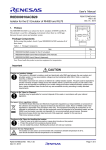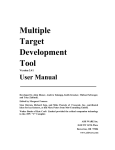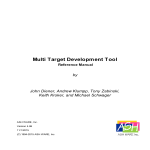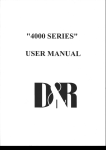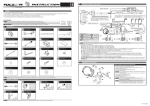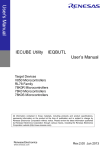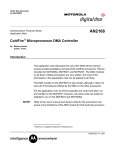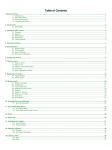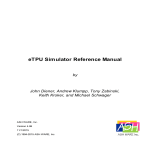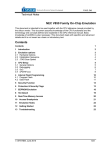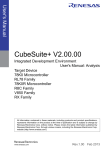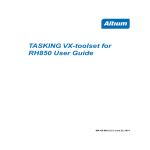Download eFLASHLOAD - Renesas Electronics
Transcript
User Manual eFLASHLOAD 32 embedded FLASH Programmer Utility for V850 and RH850 based 32-bit Microcontrollers All information contained in these materials, including products and product specifications, represents information on the product at the time of publication and is subject to change by Renesas Electronics Corp. without notice. Please review the latest information published by Renesas Electronics Corp. through various means, including the Renesas Technology Corp. website (http://www.renesas.com). www.renesas.com R01UT0177ED0301, Rev. 3.01 January 29, 2015 Notice 1. All information included in this document is current as of the date this document is issued. Such information, however, is subject to change without any prior notice. Before purchasing or using any Renesas Electronics products listed herein, please confirm the latest product information with a Renesas Electronics sales office. Also, please pay regular and careful attention to additional and different information to be disclosed by Renesas Electronics such as that disclosed through our website. 2. Renesas Electronics does not assume any liability for infringement of patents, copyrights, or other intellectual property rights of third parties by or arising from the use of Renesas Electronics products or technical information described in this document. No license, express, implied or otherwise, is granted hereby under any patents, copyrights or other intellectual property rights of Renesas Electronics or others. 3. You should not alter, modify, copy, or otherwise misappropriate any Renesas Electronics product, whether in whole or in part. 4. Descriptions of circuits, software and other related information in this document are provided only to illustrate the operation of semiconductor products and application examples. You are fully responsible for the incorporation of these circuits, software, and information in the design of your equipment. Renesas Electronics assumes no responsibility for any losses incurred by you or third parties arising from the use of these circuits, software, or information. 5. When exporting the products or technology described in this document, you should comply with the applicable export control laws and regulations and follow the procedures required by such laws and regulations. You should not use Renesas Electronics products or the technology described in this document for any purpose relating to military applications or use by the military, including but not limited to the development of weapons of mass destruction. Renesas Electronics products and technology may not be used for or incorporated into any products or systems whose manufacture, use, or sale is prohibited under any applicable domestic or foreign laws or regulations. 6. Renesas Electronics has used reasonable care in preparing the information included in this document, but Renesas Electronics does not warrant that such information is error free. Renesas Electronics assumes no liability whatsoever for any damages incurred by you resulting from errors in or omissions from the information included herein. 7. Renesas Electronics products are classified according to the following three quality grades: “Standard”, “High Quality”, and “Specific”. The recommended applications for each Renesas Electronics product depends on the product’s quality grade, as indicated below. You must check the quality grade of each Renesas Electronics product before using it in a particular application. You may not use any Renesas Electronics product for any application categorized as “Specific” without the prior written consent of Renesas Electronics. Further, you may not use any Renesas Electronics product for any application for which it is not intended without the prior written consent of Renesas Electronics. Renesas Electronics shall not be in any way liable for any damages or losses incurred by you or third parties arising from the use of any Renesas Electronics product for an application categorized as “Specific” or for which the product is not intended where you have failed to obtain the prior written consent of Renesas Electronics. R01UT0177ED0301 Rev. 3.01 User Manual 2 8. The quality grade of each Renesas Electronics product is “Standard” unless otherwise expressly specified in a Renesas Electronics data sheets or data books, etc. “Standard”: Computers; office equipment; communications equipment; test and measurement equipment; audio and visual equipment; home electronic appliances; machine tools; personal electronic equipment; and industrial robots. “High Quality”: Transportation equipment (automobiles, trains, ships, etc.); traffic control systems; anti-disaster systems; anti- crime systems; safety equipment; and medical equipment not specifically designed for life support. “Specific”: Aircraft; aerospace equipment; submersible repeaters; nuclear reactor control systems;medical equipment or systems for life support (e.g. artificial life support devices or systems), surgical implantations, or healthcare intervention (e.g. excision, etc.), and any other applications or purposes that pose a direct threat to human life. 9. You should use the Renesas Electronics products described in this document within the range specified by Renesas Electronics, especially with respect to the maximum rating, operating supply voltage range, movement power voltage range, heat radiation characteristics, installation and other product characteristics. Renesas Electronics shall have no liability for malfunctions or damages arising out of the use of Renesas Electronics products beyond such specified ranges. 10. Although Renesas Electronics endeavors to improve the quality and reliability of its products, semiconductor products have specific characteristics such as the occurrence of failure at a certain rate and malfunctions under certain use conditions. Further, Renesas Electronics products are not subject to radiation resistance design. Please be sure to implement safety measures to guard them against the possibility of physical injury, and injury or damage caused by fire in the event of the failure of a Renesas Electronics product, such as safety design for hardware and software including but not limited to redundancy, fire control and malfunction prevention, appropriate treatment for aging degradation or any other appropriate measures. Because the evaluation of microcomputer software alone is very difficult, please evaluate the safety of the final products or system manufactured by you. 11. Please contact a Renesas Electronics sales office for details as to environmental matters such as the environmental compatibility of each Renesas Electronics product. Please use Renesas Electronics products in compliance with all applicable laws and regulations that regulate the inclusion or use of controlled substances, including without limitation, the EU RoHS Directive. Renesas Electronics assumes no liability for damages or losses occurring as a result of your noncompliance with applicable laws and regulations. 12. This document may not be reproduced or duplicated, in any form, in whole or in part, without prior written consent of Renesas Electronics. 13. Please contact a Renesas Electronics sales office if you have any questions regarding the information contained in this document or Renesas Electronics products, or if you have any other inquiries. (Note 1) “Renesas Electronics” as used in this document means Renesas Electronics Corporation and also includes its majority- owned subsidiaries. (Note 2) “Renesas Electronics product(s)” means any product developed or manufactured by or for Renesas Electronics. R01UT0177ED0301 Rev. 3.01 User Manual 3 Regional Information Some information contained in this document may vary from country to country. Before using any Renesas Electronics product in your application, please contact the Renesas Electronics office in your country to obtain a list of authorized representatives and distributors. They will verify: Device availability Ordering information Product release schedule Availability of related technical literature Development environment specifications (for example, specifications for third-party tools and components, host computers, power plugs, AC supply voltages, and so forth) Network requirements In addition, trademarks, registered trademarks, export restrictions, and other legal issues may also vary from country to country. Visit http://www.renesas.com to get in contact with your regional representatives and distributors. R01UT0177ED0301 Rev. 3.01 User Manual 4 Table of Contents Chapter 1 1.1 Warranty Disclaimer ............................................................ 8 Limitation of Liability ...................................................................................... 8 Chapter 2 Introduction ......................................................................... 9 Chapter 3 FLASH monitor program ................................................... 11 3.1 3.2 Parameter / Command Interface................................................................... 11 FLASH Monitor Commands .......................................................................... 13 3.2.1 3.2.2 3.2.3 3.2.4 3.2.5 3.3 3.4 FLASH monitor program structure .............................................................. 20 FLASH monitor memory mapping ............................................................... 23 Chapter 4 4.1 Device Setup dialog ........................................................................................................32 FLASH Monitor Setup dialog ..........................................................................................34 FLASH Image setup dialog .............................................................................................36 Connect / Disconnect button ..........................................................................................38 Blank check button .........................................................................................................38 Erase button .....................................................................................................................38 Program button ................................................................................................................38 Verify button.....................................................................................................................38 E.P.V. button ....................................................................................................................38 User button .......................................................................................................................38 Delete button ....................................................................................................................38 Action log window ......................................................................................... 39 Programming Parameter Window ................................................................ 40 eFLASHLOAD Status bar .............................................................................. 41 Chapter 5 5.1 5.2 [File] menu ........................................................................................................................26 [Setup] menu ....................................................................................................................29 [Help] menu ......................................................................................................................30 eFLASHLOAD Tool bar ................................................................................. 31 4.2.1 4.2.2 4.2.3 4.2.4 4.2.5 4.2.6 4.2.7 4.2.8 4.2.9 4.2.10 4.2.11 4.3 4.4 4.5 eFLASHLOAD GUI ............................................................. 25 eFLASHLOAD Menu bar ............................................................................... 26 4.1.1 4.1.2 4.1.3 4.2 Blank check command ....................................................................................................14 Erase command ...............................................................................................................15 Program command ..........................................................................................................16 Verify command ...............................................................................................................17 User Command ................................................................................................................19 Command line interface .................................................... 42 Command line options .................................................................................. 43 Return Codes ................................................................................................. 44 R01UT0177ED0301 Rev. 3.01 User Manual 5 List of Figures Figure 1 eFLASHLOAD System Overview..................................................................... 10 Figure 2 Command / Parameter area ............................................................................ 11 Figure 3 Example of verify function ................................................................................ 18 Figure 4 FLASH monitor program structure ................................................................... 20 Figure 5 FLASH monitor prototypes and defines ........................................................... 22 Figure 6 FLASH monitor memory mapping.................................................................... 24 Figure 7 Graphical user interface ................................................................................... 25 Figure 8 File menu ......................................................................................................... 26 Figure 9 XML based configuration file............................................................................ 27 Figure 10 Setup menu, auto connect off ........................................................................ 29 Figure 11 Setup menu, auto connect on ........................................................................ 29 Figure 12 About eFLASHLOAD dialog........................................................................... 30 Figure 13 eFLASHLOAD tool bar .................................................................................. 31 Figure 14 Device Setup Dialog ...................................................................................... 32 Figure 15 Device and Config file information ................................................................. 33 Figure 16 FLASH Monitor Setup dialog ......................................................................... 34 Figure 17 FLASH Monitor File information ..................................................................... 35 Figure 18 FLASH Image Setup dialog ........................................................................... 36 Figure 19 FLASH Image File information ....................................................................... 37 Figure 20 Action log window .......................................................................................... 39 Figure 21 Programming Parameter Window .................................................................. 40 Figure 22 Status bar ...................................................................................................... 41 Figure 23 Command line interface ................................................................................. 42 Figure 24 Command line error message........................................................................ 43 R01UT0177ED0301 Rev. 3.01 User Manual 6 List of Tables Table 1 eFL structure elements ..................................................................................... 13 Table 2 Monitor commands ........................................................................................... 13 Table 3 Blank check command ...................................................................................... 14 Table 4 Erase command ................................................................................................ 15 Table 5 Program command ........................................................................................... 16 Table 6 Verify command ................................................................................................ 17 Table 7 User command.................................................................................................. 19 Table 8 Main window areas ........................................................................................... 26 Table 9 XML predefined tags ......................................................................................... 28 Table 10 Status bar ....................................................................................................... 41 Table 11 Command line options .................................................................................... 43 R01UT0177ED0301 Rev. 3.01 User Manual 7 eFLASHLOAD Warranty Disclaimer Chapter 1 Warranty Disclaimer Because eFLASHLOAD and the FLASH Monitor examples are licensed free of charge, there is no warranty of any kind whatsoever and expressly disclaimed and excluded by Renesas, either expressed or implied, including but not limited to those for non-infringement of intellectual property, merchantability and/or fitness for the particular purpose. Renesas shall not have any obligation to maintain, service or provide bug fixes for the supplied Product(s) and/or the Application. Each User is solely responsible for determining the appropriateness of using eFLASHLOAD and the FLASH Monitor examples and assumes all risks associated with its exercise of rights under this Agreement, including, but not limited to the risks and costs of program errors, compliance with applicable laws, damage to or loss of data, programs or equipment, and unavailability or interruption of operations. 1.1 Limitation of Liability In no event shall Renesas be liable to the User for any incidental, consequential, indirect, or punitive damage (including but not limited to lost profits) regardless of whether such liability is based on breach of contract, tort, strict liability, breach of warranties, failure of essential purpose or otherwise and even if advised of the possibility of such damages. Renesas shall not be liable for any services or products provided by third party vendors, developers or consultants identified or referred to the User by Renesas in connection with eFLASHLOAD and the FLASH Monitor examples. R01UT0177ED0301 Rev. 3.01 User Manual 8 eFLASHLOAD Introduction Chapter 2 Introduction eFLASHLOAD is a software which allows the programming of embedded FLASH memories connected to a V850 or RH850 based 32-bit Microcontroller. The eFLASHLOAD GUI uses the standard Renesas Debug hardware for programming, as they were the QB-V850MINI-L On-Chip Debug Emulator, the E1 On-Chip Debug Emulator, the IECUBE and IECUBE2 In-Circuit-Emulators. eFLASHLOAD uses the standard debug interface to communicate with the target microcontroller. For V850ES and V850E1 based devices the NWIRE debug interface is used for communication, respectively for V850E2 the NEXUS debug interface. Both debugs interface types, NWIRE as well NEXUS, are JTAG based communication interfaces. For RH850 based microcontrollers the Renesas proprietary Low-Pin-Debug interface, shortened LPD, is used. The LPD interface supports a 1-pin as well 4-pin debug communication to a RH850 based target microcontroller. The software supports typical FLASH programmer functions as Blank check, Erase, Program, Verify and the sequential E.P.V. operation (Erase -> Program -> Verify). The software consists of a Windows GUI which controls a FLASH monitor program running on the target microcontroller. The communication and synchronisation between the GUI and the FLASH monitor program is done via a standardized FLASH Loader parameter and command interface. The FLASH monitor program running on the V850 or RH850 based target microcontroller is under full user responsibility and control. Therefore there is no restriction on the supported FLASH memories. By starting the eFLASHLOAD software the FLASH monitor program is loaded to the internal RAM of the V850 or RH850 based target microcontroller and executed. All programming functions can be controlled by the eFLASHLOAD GUI in the same manner as using a standard FLASH programmer GUI like PG-FP5. R01UT0177ED0301 Rev. 3.01 User Manual 9 eFLASHLOAD Introduction The minimum system requirements for using eFLASHLOAD were: Target hardware consisting of o V850 or RH850 based microcontroller o embedded FLASH memory o On-Chip debug interface or emulator interface V850 or RH850 based target microcontroller o o iRAM resources: o 4124 Bytes for the FLASH Monitor Parameter / Command area o 4 kByte ~ 16 kByte for the FLASH Monitor Program (depending on user implementation) Debug interfaces: o NWIRE (JTAG based) → V850ES, V850E1 o NEXUS (JTAG based) → V850E2 o 1-Pin and 4-Pin LPD (Low Pin Debug) → RH850 Debug Hardware o QB-V850MINI-L On-Chip debug emulator o E1 On-Chip debug emulator o IECUBE and IECUBE2 In-Circuit-Emulators Windows XP, Windows Vista or Windows 7 based PC / Workstation Note: By using the In-Circuit-Emulators IECUBE or IECUBE2, the emulator has to be supplied with target power. Figure 1 eFLASHLOAD System Overview R01UT0177ED0301 Rev. 3.01 User Manual 10 eFLASHLOAD FLASH monitor program Chapter 3 FLASH monitor program The eFLASHLOAD software installation does include a template of a FLASH monitor program. All FLASH vendor specific functions as FLASH initialisation, blank check, erase, program or verify have to be implemented by the user itself. 3.1 Parameter / Command Interface The FLASH monitor program operation is based and controlled on a common parameter / command interface. The parameter / command interface uses a reserved memory area within the internal RAM of the microcontroller. The following structure is placed into the FLASH monitor parameter area which controls the FLASH monitor operation and also indicates the status and result of a FLASH operation. Additionally a 4kByte transfer buffer is included within the structure, which stores the data to be programmed or verified during FLASH operation. Figure 2 Command / Parameter area The following table describes the elements of the eFL structure. Type Argument Description FLASH monitor command to be executed. The variable is written by eFLASHLOAD (Host) and controls the operation of the FLASH monitor program (target). The following commands are supported: unsigned integer eFL.H_cmd CMD_BLANK CMD_ERASE CMD_PROGRAM CMD_VERIFY CMD_USER The FLASH monitor program reads this variable and starts the indicated command execution. R01UT0177ED0301 Rev. 3.01 User Manual 11 eFLASHLOAD FLASH monitor program The FLASH monitor program (target) writes to this variable to acknowledge a command indicated by eFLASHLOAD (host). The target has to acknowledge the same command code indicated by the host. The following acknowledge commands are supported: unsigned integer eFL.T_cmd_ack CMD_BLANK CMD_ERASE CMD_PROGRAM CMD_VERIFY CMD_USER A cyclic read operation is performed by the eFLASHLOAD GUI to get the operating status. In case a wrong command is acknowledge by the FLASH monitor program or the command is not acknowledged in time, the operation is stopped by the eFLASHLOAD GUI and an error is displayed. The FLASH monitor program (target) notifies the status or results of the current command under execution. The following states are supported: unsigned integer eFL.T_cmd_stat BUSY PASS FAIL A cyclic read operation is performed by the eFLASHLOAD GUI to get the operating status and result. unsigned integer eFL.T_cmd_info The command info variable shows the current FLASH access address during FLASH programming and verifying. This variable has to be updated by the FLASH monitor program within the program and verify function / routine. The eFLASHLOAD GUI (host) does use this information to show and update the progress status during programming and verification. A cyclic read operation is performed by the host to update command progress information. unsigned integer eFL.H_fps_addr This variable is written by eFLASHLOAD (host) and defines the FLASH start address for the current command. unsigned integer eFL.H_fpe_addr This variable is written by eFLASHLOAD (host) and defines the FLASH end address for the current command. eFL.H_buf_size This variable is written by eFLASHLOAD (host) and defines the amount of bytes within the transfer buffer. The maximum buffer size is equal to 4096 Bytes. unsigned integer R01UT0177ED0301 Rev. 3.01 User Manual 12 eFLASHLOAD FLASH monitor program unsigned integer eFL.H_buf[1024] This is the transfer buffer for data to be written to the FLASH memory or data to be verified from the FLASH memory. The transfer buffer is written by eFLASHLOAD. The buffer size is fixed to 1024 words (4096 bytes). Table 1 eFL structure elements 3.2 FLASH Monitor Commands The following commands are supported by eFLASHLOAD. By starting a FLASH operation using the eFLASHLOAD GUI the corresponding command code and FLASH parameter set is written to the V850 or RH850 based target microcontroller. The FLASH monitor program has to acknowledge the received command in time. After this the selected operation is started. The eFLASHLOAD software performs a cyclic reading of the command status register to check the current command status. Command Code Value Blank check CMD_BLANK 0x11111111 Erase CMD_ERASE 0x22222222 Program CMD_PROGRAM 0x33333333 Verify CMD_VERIFY 0x44444444 User CMD_USER 0x77777777 Table 2 Monitor commands R01UT0177ED0301 Rev. 3.01 User Manual 13 eFLASHLOAD FLASH monitor program 3.2.1 Blank check command Blank Check Command: CMD_BLANK ( = 0x11111111) FLASH Monitor Function: unsigned int FLM_Blank() Input Parameters: Parameter Input Value eFL.H_fps_addr FLASH start address eFL.H_fps_end FLASH end address Remark Return Parameters: Parameter Return Value unsigned int PASS, FAIL eFL.H_fps_end In case of BLANK check failure, the error address is returned. Remark Table 3 Blank check command R01UT0177ED0301 Rev. 3.01 User Manual 14 eFLASHLOAD FLASH monitor program 3.2.2 Erase command Erase Check Command: CMD_ERASE ( = 0x22222222) FLASH Monitor Function: unsigned int FLM_Erase() Input Parameters: Parameter Input Value eFL.H_fps_addr FLASH start address eFL.H_fps_end FLASH end address Remark Return Parameters: Parameter Return Value unsigned int PASS, FAIL eFL.H_fps_end In case of ERASE failure, the error address is returned. Remark Table 4 Erase command R01UT0177ED0301 Rev. 3.01 User Manual 15 eFLASHLOAD FLASH monitor program 3.2.3 Program command Program Command: CMD_PROGRAM ( = 0x33333333) FLASH Monitor Function: unsigned int FLM_Program() Input Parameters: Parameter Input Value eFL.H_fps_addr FLASH operation start address eFL.H_buf_size Amount of bytes to be programmed *eFL.H_buf Data to be written to the FLASH memory Remark Update Parameters: Parameter eFL.T_cmd_info Value Current FLASH access address during programming Remark This variable has to be updated in the FLASH programming function, to indicate the progress status. Return Parameters: Parameter Return Value unsigned int PASS, FAIL eFL.H_fps_end In case of PROGRAM failure, the error address is returned. Remark Table 5 Program command R01UT0177ED0301 Rev. 3.01 User Manual 16 eFLASHLOAD FLASH monitor program 3.2.4 Verify command Verify Command: CMD_VERIFY ( = 0x44444444) FLASH Monitor Function: unsigned int FLM_Verify() Input Parameters: Parameter Input Value eFL.H_fps_addr FLASH operation start address eFL.H_buf_size Amount of bytes to be verified *eFL.H_buf Data to be verified from the FLASH memory Remark Update Parameters: Parameter eFL.T_cmd_info Value Current FLASH access address during verifying Remark This variable has to be updated in the FLASH verify function, to indicate the progress status. Return Parameters: Parameter Return Value unsigned int PASS, FAIL eFL.H_fps_end In case of VERIFY failure, the error address is returned. eFL.H_fpe_end In case of VERIFY failure, the error data is returned. Remark Table 6 Verify command R01UT0177ED0301 Rev. 3.01 User Manual 17 eFLASHLOAD FLASH monitor program An example of the FLASH monitor verification function could be similar to the following implementation. Figure 3 Example of verify function R01UT0177ED0301 Rev. 3.01 User Manual 18 eFLASHLOAD FLASH monitor program 3.2.5 User Command User Command: CMD_USER ( = 0x77777777) FLASH Monitor Function: unsigned int FLM_User() Input Parameters: None Return Parameters: Parameter Return Value unsigned int PASS, FAIL eFL.H_fps_end A user specific value can be returned. Remark Table 7 User command The User Command is a freely configurable function supported by the eFLASHLOAD GUI and the FLASH monitor program. It can be used to execute for instance test software or any other user code before or after a dedicated FLASH operation. The corresponding user code has simply to be added to the FLASH monitor program. R01UT0177ED0301 Rev. 3.01 User Manual 19 eFLASHLOAD FLASH monitor program 3.3 FLASH monitor program structure As reference a skeleton of the FLASH monitor program running on the V850 target microcontroller is shown in the figure below. Figure 4 FLASH monitor program structure R01UT0177ED0301 Rev. 3.01 User Manual 20 eFLASHLOAD FLASH monitor program After entering the main function, the FLASH is initialized by calling function “FLM_Init()”. The init function returns a PASS or FAIL information, which is checked by eFLASHLOAD. Within the endless loop the main body of the FLASH monitor program can be found. The monitor program reads the FLASH monitor command variable “eFL.H_cmd” written by eFLASHLOAD and branches to the corresponding case. R01UT0177ED0301 Rev. 3.01 User Manual 21 eFLASHLOAD FLASH monitor program Within the case the command is acknowledge by the monitor by writing to the FLASH monitor command acknowledge register “eFL.T_cmd_ack”. After this the command status register is changed to BUSY and the command is executed by calling the corresponding FLASH function as they are FLM_Blank(), FLM_Erase(), FLM_Write(), FLM_Verify() and FLM_User(). The corresponding FLASH function returns a PASS or FAIL information, which indicates if the FLASH operation was successfully. The result is checked by eFLASHLOAD. After a FLASH operation is finished the FLASH monitor command variable is set to PASS and the FLASH monitor program is ready to receive the next command from the host (eFLASHLOAD). The following prototypes and defines are used by the FLASH monitor program. Figure 5 FLASH monitor prototypes and defines R01UT0177ED0301 Rev. 3.01 User Manual 22 eFLASHLOAD FLASH monitor program 3.4 FLASH monitor memory mapping The FLASH programming GUI allows and restricts the monitor program download and monitor execution only to and from the internal RAM of the target microcontroller. Downloading to the internal FLASH memory of the microcontroller is not supported. The eFLASHLOAD GUI checks the mapping of the FLASH monitor program code which must fit to the iRAM area of the V850 or RH850 based microcontroller. Additionally to this, the FLASH parameter / area which is used as communication and synchronisation interface between the eFLASHLOAD GUI and the FLASH monitor program must be placed to the internal RAM of the microcontroller as well. A sample of the FLASH monitor memory mapping for a V850E2/Dx4 device and the Green Hills tool chain is shown in the next figure. R01UT0177ED0301 Rev. 3.01 User Manual 23 eFLASHLOAD FLASH monitor program FLASH monitor start address FLASH monitor program including code and constants FLASH monitor variables and stack FLASH monitor parameter area (user defined section) FLASH monitor memory mapping Corresponding eFLASHLOAD setting and configuration Figure 6 FLASH monitor memory mapping R01UT0177ED0301 Rev. 3.01 User Manual 24 eFLASHLOAD eFLASHLOAD GUI Chapter 4 eFLASHLOAD GUI The graphical user interface of eFLASHLOAD allows an easy and an intuitive configuration and handling. When starting the eFLASHLOAD GUI a screen similar to the following one will appear. Some commands and functions me be unavailable when the GUI is started, depending on the specified configuration. <4> Programmer parameter window <1> Menu bar <2> Tool bar <3> Action log window <6> Hint bar <5> Status bar Figure 7 Graphical user interface R01UT0177ED0301 Rev. 3.01 User Manual 25 eFLASHLOAD eFLASHLOAD GUI The main window consists of the following areas. Name Displayed Items <1> Menu bar Menu items executable by the programming GUI <2> Tool bar Frequently used commands, as buttons <3> Action log window A programming GUI action log <4> Programmer parameter window Programming parameter settings <5> Status bar Command progress shown as a color or with a message <6> Hint bar Hints for commands and toolbar Table 8 Main window areas 4.1 eFLASHLOAD Menu bar The menu bar of the embedded FLASH programmer GUI allows to load or save the tool configuration and to configure the GUI. 4.1.1 [File] menu The file menu allows to load an existing or stored the current FLASH programmer configuration. The configuration consists of the target device, FLASH monitor and FLASH image settings. The configuration is stored within the XML file format. (1) (2) (3) Figure 8 File menu (1) Load XML based configuration file. (2) Save XML based configuration file. (3) Exit FLASH programmer GUI. R01UT0177ED0301 Rev. 3.01 User Manual 26 eFLASHLOAD eFLASHLOAD GUI The XML based configuration file and the corresponding tags are shown below. Figure 9 XML based configuration file R01UT0177ED0301 Rev. 3.01 User Manual 27 eFLASHLOAD eFLASHLOAD GUI The predefined tags are: eFLASHLOAD Defining the start of the configuration file DeviceSection Defining the device setup configuration DEVICE_FILE Specifies the device file DEVICE_OCDSECID Specifies the OCD security ID DEVICE_CLOCK Specifies the device clock (target frequency) Specifies the debug interface type: DEVICE_DEBUGINTERFACE For V850 based products this tag is ignored. The debug interface is fixed to JTAG. For RH850 based products the 1-pin LPD or 4-pin LPD Debug Interface must be chosen. The following settings are supported: LPD1PIN LPD4PIN Specifies the speed of the debug interface: DEVICE_DEBUGSPEED For V850 based products this tag is ignored. The debug interface speed is fixed to 10MHz. For RH850 based products please specify the speed as following: → For 1-pin LPD specify a baudrate of: 2000, 1000 or 500 Kbps. → For 4-pin LPD specify a LPD clock of: 16500, 11000 or 5500 KHz. DEVICE_AUTOCON Specifies if auto connection is enabled or disabled. Possible settings are: on / off MonitorSection Defining the FLASH monitor setup configuration MONITOR_FILE Specifies the FLASH monitor file MONITOR_SADDR Specifies the FLASH monitor start address MONITOR_PADDR Specifies the FLASH monitor parameter area base address FlashSection Defining the FLASH image setup configuration FLASH_FILE Specifies the FLASH image file FLASH_ADDROFFSET Specifies the FLASH address offset Table 9 XML predefined tags R01UT0177ED0301 Rev. 3.01 User Manual 28 eFLASHLOAD eFLASHLOAD GUI 4.1.2 [Setup] menu The setup menu allows the configuration of the connection mode. By selecting “Auto connect” to off, the user has to establish the debug communication to the target device manually. This is done by pressing the connect button within the tool bar. After the corresponding FLASH operation was executed, for instance blank check, erase, program or verify, the user has to close the debug communication by pressing the connect button ones again. Only if “Auto connect” is to off, the connect button is visible. Connect button, enabled Figure 10 Setup menu, auto connect off In case “Auto connect” is set to on, the communication to the target device is establish automatically. By performing a corresponding FLASH operation, for instance blank check, erase, program or verify, the debug communication is established first, the FLASH operation is executed and afterwards the debug communication is closed. The connect button is disabled in case “Auto connect” is set to on. Connect button, disabled Figure 11 Setup menu, auto connect on R01UT0177ED0301 Rev. 3.01 User Manual 29 eFLASHLOAD eFLASHLOAD GUI 4.1.3 [Help] menu The help menu shows the release and version information of the FLASH programmer GUI. Figure 12 About eFLASHLOAD dialog R01UT0177ED0301 Rev. 3.01 User Manual 30 eFLASHLOAD eFLASHLOAD GUI 4.2 eFLASHLOAD Tool bar The tool bar contains buttons to configure the embedded FLASH programmer GUI and to start all key functions quickly. The following buttons and corresponding functions are offered by eFLASHLOAD. Opens the Device Setup dialog box. Opens the FLASH Monitor Setup dialog box. Opens the FLASH Image Setup dialog box. Executes the connect command or disconnect command. Executes the [Blank Check] command. Executes the [Erase] command. Executes the [Program] command. Executes the [Verify] command. Executes the [Autoprocedure(E.P.V.)] command. (Erase -> Program -> Verify). Executes the [User] command. Deletes all settings Figure 13 eFLASHLOAD tool bar R01UT0177ED0301 Rev. 3.01 User Manual 31 eFLASHLOAD eFLASHLOAD GUI 4.2.1 Device Setup dialog The device setup dialog allows to setup the target microcontroller. By selecting this menu item the following dialog window appears and offers the possibility to specify the corresponding V850 or RH850 based device file, the OCD security ID, the device clock (target frequency), the debug interface and the debug interface clock. Figure 14 Device Setup Dialog Notes: For V850 based products the Debug Interface and Debug Interface Clock can not be changed. The Debug Interface is fixed to JTAG (NWIRE/NEXUS) and the Debug Interface Speed is fixed to 10MHz. For RH850 based products only the 1-pin LPD or 4-pin LPD Debug Interface can be chosen. R01UT0177ED0301 Rev. 3.01 User Manual o For 1-pin LPD specify a debug interface speed (baudrate) of: 2000, 1000 or 500 (Kbps). o For 4-pin LPD specify a debug interface speed (LPD clock) of: 16500, 11000 or 5500 (KHz). 32 eFLASHLOAD eFLASHLOAD GUI The <Clear> button offers the possibility to delete the current device settings. After the device setup has been finished the programmer parameter window is updated accordingly. Figure 15 Device and Config file information R01UT0177ED0301 Rev. 3.01 User Manual 33 eFLASHLOAD eFLASHLOAD GUI 4.2.2 FLASH Monitor Setup dialog The FLASH monitor setup dialog allows to select and setup the FLASH monitor program to be executed. By selecting this menu item the following dialog window appears and offers the possibility to specify the corresponding FLASH monitor, the FLASH monitor start address and the start address of the FLASH monitor parameter area. Figure 16 FLASH Monitor Setup dialog The FLASH monitor file has to be available in an Intel-Hex or Motorola-S record format. For Intel-hex the extended linear address record and extended segment address record formats are supported. With regard to the Motorola-S record type the S3 record format is supported. The FLASH monitor start address defines the entry address of the monitor program, equal to the reset address of the monitor program. Please note that the monitor start address must fit to the address range of the FLASH monitor file. The FLASH parameter area start address defines the base address of the parameter and command area which is used for communication and synchronization between the eFLASHLOAD GUI and the FLASH monitor program. Please note that the parameter area start address must not point into the address area of the FLASH monitor file. R01UT0177ED0301 Rev. 3.01 User Manual 34 eFLASHLOAD eFLASHLOAD GUI The <Clear> button offers the possibility to delete the current FLASH monitor settings. After the FLASH monitor setup has been finished the programmer parameter window is updated accordingly. Figure 17 FLASH Monitor File information R01UT0177ED0301 Rev. 3.01 User Manual 35 eFLASHLOAD eFLASHLOAD GUI 4.2.3 FLASH Image setup dialog The FLASH image setup dialog allows to select and setup the FLASH image to be programmed to the FLASH memory. By selecting this menu item the following dialog window appears and offers the possibility to specify the corresponding FLASH image and the address offset. Figure 18 FLASH Image Setup dialog The FLASH image file has to be available in an Intel-Hex or Motorola-S record format. For Intel-hex the extended linear address record and extended segment address record formats are supported. With regard to the Motorola-S record type the S2 and S3 record format is supported. R01UT0177ED0301 Rev. 3.01 User Manual 36 eFLASHLOAD eFLASHLOAD GUI The FLASH image address offset can be specified as a signed integer. The resulting target address for the FLASH operation is displayed within the programmer parameter window after the FLASH image setup has been finished. The <Clear> button offers the possibility to delete the current FLASH image settings. Figure 19 FLASH Image File information R01UT0177ED0301 Rev. 3.01 User Manual 37 eFLASHLOAD eFLASHLOAD GUI 4.2.4 Connect / Disconnect button By pressing this button the debug interface connection to the target microcontroller is established. In case a connection was already established the communication is closed (disconnected). The button is only visible in case “Auto connect” is set to off. 4.2.5 Blank check button By pressing this button the FLASH programmer GUI performs the blank check command. 4.2.6 Erase button By pressing this button the FLASH programmer GUI performs the erase command. 4.2.7 Program button By pressing this button the FLASH programmer GUI performs the program command. 4.2.8 Verify button By pressing this button the FLASH programmer GUI performs the verify command. 4.2.9 E.P.V. button By pressing this button the FLASH programmer GUI performs the sequential E.P.V. command (Erase -> Program -> Verify). 4.2.10 User button By pressing this button the FLASH programmer GUI performs the user command. 4.2.11 Delete button By pressing this button all configurations including the device, FLASH monitor and FLASH image settings were cleared. R01UT0177ED0301 Rev. 3.01 User Manual 38 eFLASHLOAD eFLASHLOAD GUI 4.3 Action log window This window displays the log of programming GUI actions. Figure 20 Action log window R01UT0177ED0301 Rev. 3.01 User Manual 39 eFLASHLOAD eFLASHLOAD GUI 4.4 Programming Parameter Window This window displays the programming parameter settings. Figure 21 Programming Parameter Window [Device and Config File] area Displays information such as the device file, device file version and loaded configuration file. [Target Device] area Displays information such as the device name, OCD security ID code, device clock, debug interface, debug interface speed settings and target device iRAM mapping / resources. [FLASH Monitor File] area Displays information such as the FLASH monitor file, the monitor address area, start address and parameter area start address. R01UT0177ED0301 Rev. 3.01 User Manual 40 eFLASHLOAD eFLASHLOAD GUI [FLASH Image File] area Displays information such as the FLASH image file, the image address area, the address offset and target address area. 4.5 eFLASHLOAD Status bar The status bar shows the current status and the progress of a command under execution. Figure 22 Status bar Immediately after the programming GUI is started Establishing of the debug connection to the target device in progress. The target device is ready to receive a new command A command execution is in progress A command execution is completed normally A command execution is terminated abnormal Table 10 Status bar R01UT0177ED0301 Rev. 3.01 User Manual 41 eFLASHLOAD Command line interface Chapter 5 Command line interface Beside the graphical user interface the FLASH programmer GUI provides a command line interface to support batch mode operation or automatic FLASH operations. The syntax for the command line interface is as following: eFLASHLOAD –xml <config filename> -<command> By executing the embedded FLASH programmer GUI without any options from the command line the graphical user interface is started. Additionally, by starting the GUI only with the configuration file specified, the graphical user interface is started and configured according to the configuration file. By running the embedded FLASH programmer GUI via the command line interface all status information, process information and operation results are displayed in the command shell window. Figure 23 Command line interface R01UT0177ED0301 Rev. 3.01 User Manual 42 eFLASHLOAD Command line interface 5.1 Command line options The following command line options are supported by the embedded FLASH programmer: Command -xml <configuration file> Definition -bln executes the [Blank Check] command -ers executes the [Erase] command -prg executes the [Program] command -vrf executes the [Verify] command -epv executes the [Autoprocedure(E.P.V.)] command. (Erase -> Program -> Verify). -usr executes the [User] command specifies the configuration file to be loaded Table 11 Command line options By running the eFLASHLOAD programmer only one FLASH operation command can be passed at a time, example: eFLASHLOAD –xml Dx4_NOR_FLASH.xml -epv By passing more than one FLASH operation command to the eFLASHLOAD programmer an error message is displayed. Figure 24 Command line error message R01UT0177ED0301 Rev. 3.01 User Manual 43 eFLASHLOAD Command line interface 5.2 Return Codes For using the embedded FLASH programmer within an automated programming flow, different return codes are generated depending on the FLASH operation result. In case the FLASH operation was successfully the FLASH programmer returns value “0” (zero). Otherwise in case of errors during FLASH operation the value “-1” (minus one) is returned by the embedded FLASH programmer software. R01UT0177ED0301 Rev. 3.01 User Manual 44 Revision History Description Rev. Date 1.00 January 07, 2011 - First Edition Issued 2.00 March 15, 2011 - Added V850ES and V850E1 Core support 2.01 September 24, 2012 - Added E1 On-Chip Debug Emulator support 3.00 July 3, 2014 - 3.01 January 29, 2015 - R01UT0177ED0301 Rev. 3.01 User Manual Page Summary Added RH850 Core support Added User Command support Aligned Bookmark Linkage 45 SALES OFFICES http://www.renesas.com Refer to "http://www.renesas.com/" for the latest and detailed information. Renesas Electronics America Inc. 2880 Scott Boulevard Santa Clara, CA 95050-2554, U.S.A. Tel: +1-408-588-6000, Fax: +1-408-588-6130 Renesas Electronics Canada Limited 1101 Nicholson Road, Newmarket, Ontario L3Y 9C3, Canada Tel: +1-905-898-5441, Fax: +1-905-898-3220 Renesas Electronics Europe Limited Dukes Meadow, Millboard Road, Bourne End, Buckinghamshire, SL8 5FH, U.K Tel: +44-1628-585-100, Fax: +44-1628-585-900 Renesas Electronics Europe GmbH Arcadiastrasse 10, 40472 Düsseldorf, Germany Tel: +49-211-65030, Fax: +49-211-6503-1327 Renesas Electronics (China) Co., Ltd. 7th Floor, Quantum Plaza, No.27 ZhiChunLu Haidian District, Beijing 100083, P.R.China Tel: +86-10-8235-1155, Fax: +86-10-8235-7679 Renesas Electronics (Shanghai) Co., Ltd. Unit 204, 205, AZIA Center, No.1233 Lujiazui Ring Rd., Pudong District, Shanghai 200120, China Tel: +86-21-5877-1818, Fax: +86-21-6887-7858 / -7898 Renesas Electronics Hong Kong Limited Unit 1601-1613, 16/F., Tower 2, Grand Century Place, 193 Prince Edward Road West, Mongkok, Kowloon, Hong Kong Tel: +852-2886-9318, Fax: +852 2886-9022/9044 Renesas Electronics Taiwan Co., Ltd. 7F, No. 363 Fu Shing North Road Taipei, Taiwan Tel: +886-2-8175-9600, Fax: +886 2-8175-9670 Renesas Electronics Singapore Pte. Ltd. 1 harbourFront Avenue, #06-10, keppel Bay Tower, Singapore 098632 Tel: +65-6213-0200, Fax: +65-6278-8001 Renesas Electronics Malaysia Sdn.Bhd. Unit 906, Block B, Menara Amcorp, Amcorp Trade Centre, No. 18, Jln Persiaran Barat, 46050 Petaling Jaya, Selangor Darul Ehsan, Malaysia Tel: +60-3-7955-9390, Fax: +60-3-7955-9510 Renesas Electronics Korea Co., Ltd. 11F., Samik Lavied' or Bldg., 720-2 Yeoksam-Dong, Kangnam-Ku, Seoul 135-080, Korea Tel: +82-2-558-3737, Fax: +82-2-558-5141 © 2010 Renesas Electronics Corporation. All rights reserved. Colophon 1.0 R01UT0177ED0301 Rev. 3.01 User Manual 46 eFLASHLOAD R01UT0177ED0301















































